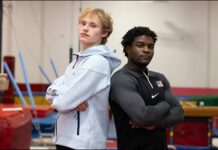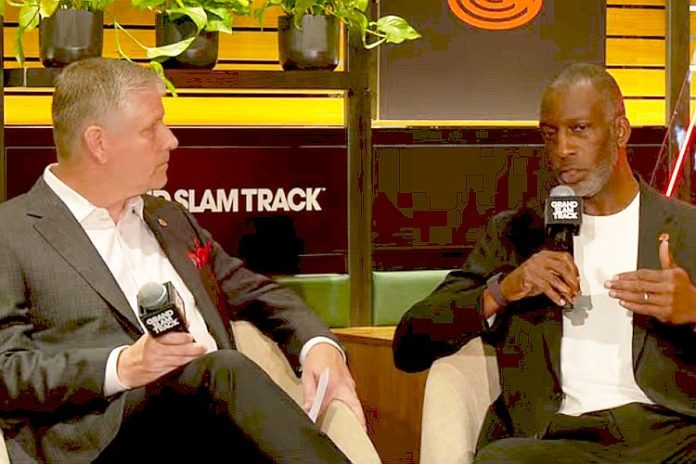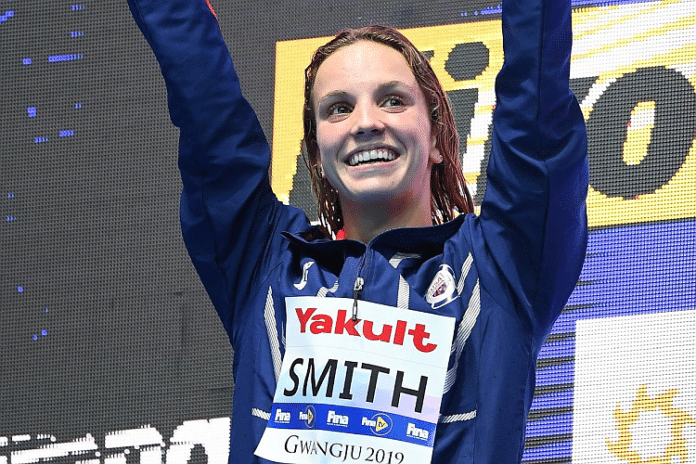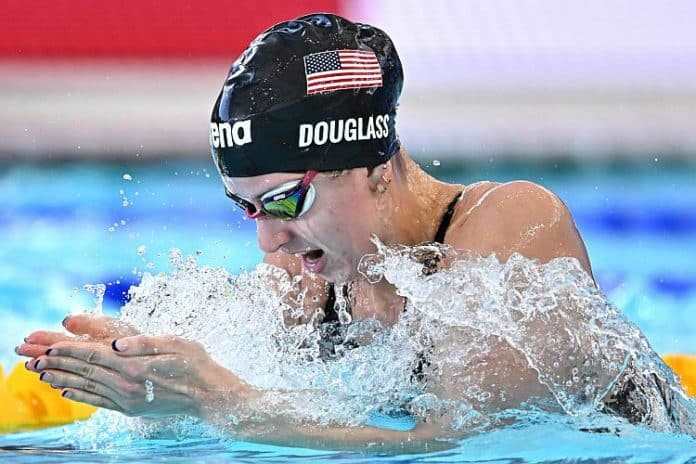★ The Sports Examiner: Chronicling the key competitive, economic and political forces shaping elite sport and the Olympic Movement.★
★ To get The Sports Examiner by e-mail: sign up here! ★
★ Friends: Another! Now 14 donors have covered 27% of our summer ask for technical support expenses. If you can support our coverage, please donate here. Your enthusiasm is the reason this site continues. It really is. ★
≡ THE 5-RING CIRCUS ≡
1. Michael Johnson’s “Grand Slam Track” unveiled for 2025
2. “I’m so excited to just be a part of a real, professional track league”
3. Can the Grand Slam Track project actually work?
4. Smith smashes women’s world 100 m Back record at U.S. Swim Trials
5. Ralph Lauren unveils U.S. ceremonies uniforms for Paris
● Atlanta 1996 double gold medalist Michael Johnson announced his “Grand Slam Track” project to begin in 2025, with four meets – “Slams” – which will feature two-race competitions in six event groups and pay from $100,000 to each winner, down to $10,000 for eighth, not including appearance fees.
● Johnson announced Sydney McLaughlin-Levrone as Grand Slam Track’s first contracted athlete and they and Carl Lewis appeared in a discussion in Los Angeles, and Johnson explained why no field events will be included. He also noted that the Grand Slam Track program is not meant to displace other events, such as the Diamond League.
● Can Grand Slam Track work and revolutionize the sport? Maybe, but it won’t be easy. Only 96 athletes will be part of the Grand Slam Track program in 2025 and they will be clear winners. But if successful, it will also help to support both USA Track & Field and even World Athletics. There was no mention of doping control, and field event athletes are clear losers in this concept.
● Backstroke star Regan Smith was the talk of the U.S. Olympic Swimming Trials in Indianapolis, crushing the world record in the women’s 100 m Backstroke in 57.13! Tokyo Olympic champ Bobby Finke won the men’s 800 m Free and will defend his title in Paris. But there was a lot more going on in Indy!
● Official outfitter Ralph Lauren unveiled the U.S. Olympic and Paralympic Uniforms for the Paris opening and closing ceremonies, with snappy blazers and blue jeans for the opening, and a more casual jacket and white jeans for the closing. The pieces are available for purchase if you’re interested!
● U.S. Olympic Trials: Diving (Duncan and Downs win tight battle to claim men’s 3 m Synchro berth in Paris) ●
● Panorama: Paris 2024 (Inside The Games site will not receive accreditation) = Archery (U.S. men miss last chance for Paris qualifying) = Athletics (2: Jacobs wins in Turku in 9.92!; USATF announces Neutrogena sponsorship) = Cycling (Vollering wins Tour de Suisse Women) = Football (Turkey and Portugal win final first-round games at EURO 2024) = Ice Hockey (IIHF names Spooner as women’s Player of the Year) = Shooting (Hancock and Smith win Mixed Skeet at ISSF World Cup) ●
1.
Michael Johnson’s “Grand Slam Track” unveiled for 2025
Back on 1 June 2022, 1996 Atlanta Olympic double gold medalist Michael Johnson published a lengthy Twitter thread that included:
● “1/7 I asked what sport represents a successful example of what track & field could be or should be. In the thread below I have listed my response to some of the replies, and end with my opinion what the sport needs to achieve it’s potential.”
● “4/7 Tennis/Golf. Individual sports, most comparable to track. 4 ‘Majors’ every year serve as the pinnacle. T&F calendar is confusing & crowded. Olympics, World Champs, 14 Diamond League events. All presented as major, but Olympics is ‘The Major’, and not controlled by the sport.”
On Tuesday, Johnson unveiled “Grand Slam Track,” a new venture to launch in 2025, closely modeled on the golf and tennis model:
● Four meets per year, with the first in April and three over the summer, but toward the beginning of the season. One meet will take place in the Los Angeles area, another in the U.S. and two more outside of the U.S. The sites have been selected, but the announcements will be made later.
● The program will include just 96 athletes – all in track, no field – with 48 “Racers” contracted to compete annually in all four “Slams,” and who will receive a salary for their participation, but also be eligible for prize money. Another 48 will be contracted, with an appearance fee, to compete in one or more Slams, based on their performance. A “Grand Slam Track Racing Committee” will make the decisions on invitations.
● Each “Slam” will take place over three days, in a three-hour daily television window with competition in six groupings, in which the athletes will race in two events:
= Short sprints (100 m/200 m)
= Short hurdles (100 m hurdles or 110 m hurdles/100 m)
= Long sprints (200 m/400 m)
= Long hurdles (400 m hurdles/400 m)
= Short distance (800 m/1,500 m)
= Long distance (3,000 m/5,000 m)
Athlete placings in their two events will be scored 10-8-6-5-4-3-2-1. Assuming both groups are held for men and women each time, there will be eight athletes per event group, and 96 athletes per meet.
● Winners of each event group will win $100,000 in prize money, with further awards for places 2-8 of $50,000-30,000-25,000-20,000-15,000-12,500-10,000.
The prize money total per event group is $262,500 and for each Slam, a total of $3.15 million, so $12.60 million for all four Slams in total.
The emphasis is on competition, with no pacesetters or pacing lights, and athletes will wear their own uniforms, with no bibs. No teams, everything is on the individual athlete. And 400 m hurdles world-record holder and Olympic gold medalist Sydney McLaughlin-Levrone has been signed as the first “Racer” athlete.
The introductory news release explained the funding: “Grand Slam Track has secured more than $30 million in financial commitments from investors and strategic partners for the launch of the league. Winners Alliance, a global, athlete-centric commercial solution and Johnson’s operating partner, was the lead investor in the first fundraising close for the new venture.”
Tuesday was the start, and there are still more questions than answers. No information on meet dates, ticket prices or television partners was provided, but with more details promised over the summer.
2.
“I’m so excited to just be a part of a real, professional track league”
Michael Johnson introduced his Grand Slam Track program at a 31-minute presentation in Los Angeles, hosted by ESPN anchor John Anderson and featuring Sydney McLaughlin-Levrone and Carl Lewis, who has been pushing the issue of athlete pay since the 1980s.
Johnson started with, “It’s an exciting day” and went on to explain how he sees his project:
● “This is a new day for track and field. … This new league will revolutionize the sport, bring track back to the forefront, and make sure that going forward that athletes in this sports and fans in this sport get what they’ve been asking for, for so many years now.”
● “Right now, we are witnessing the greatest collection of amazing personalities in this sport. I have never seen so many amazing personalities all at once, in the sport, willing to put themselves out there, wanting to connect with their fans, and these athletes are doing a great job already with their social media.
“We are also seeing performances at a level we haven’t seen in quite some time, so the performances, the athletes are at a level that is unprecedented.
“In addition to that, in sports in general, we are seeing we are seeing a level of investment in sport and interest in sport at an all-time level. So, there’s been no better time that I’ve seen in the last 30 years or so where track and field as a sport is positioned to just explode and that’s what we’re doing with Grand Slam Track.”
● “Our 48 Grand Slam Track Racers compete in all four “Slams” throughout the year; the other four challengers can actually unlock a lane during the season for one or more of those Slams. But the great thing about this league is that we now have athletes under contract who compete against one another four times a year and are guaranteed to be there. That’s what our fans have been asking for in track and field: the ability to see the athletes, know that they are going to be there and that’s it’s going to be the best against the best. …
“During the season, as athletes run fast times, they enter the conversation as a challenger, they enter the conversation as one of the best in that event … we have the ability now with our committee – if we select that person – to bring them in.”
McLaughlin-Levrone, who trains in Los Angeles, came on to express her enthusiasm for the concept, saying:
“Very excited to be a part of this endeavor. Michael’s done a great job putting this together and just knowing that the future of track and field can grow exponentially and that athletes will have the opportunity to just grow this sport and it’s in a place ready to do that. …
“I’m so excited to just be a part of a real, professional track league.”
She also touched on very limited competition schedule and why she is interested in the new project:
“Because track is so kind of sporadic in how it’s set up, people expect crazy times and crazy performances every time they see us because they don’t see us that often. And I think this will kind of normalize seeing people through training cycles, in different parts of their training, but still seeing the best of the best compete, to the point where they’re just enjoying the fact that we get to race one another.
“And seeing a good race, as opposed to always expecting something amazing and spectacular.”
Lewis, the nine-time Olympic gold medalist who is now the coach at the University of Houston, endorsed the idea of essentially a four-meet tour:
“If you go to any Grand Slam in tennis or golf, you know the best are going to be there, so you actually plan to watch the U.S. Open because you know they’ll be there. Right now, you don’t know that.”
He also emphasized the athlete-first aspect of the Grand Slam Track idea:
“Now, everyone’s making their own schedule, and the best thing about this to me is it allows you to know, ‘this is the schedule,’ ‘this grand Slam is going to be here every single year,’ the dates are not going to change and we know what the benefits are, financially.
“This would have been great [for past athletes] and it gives the athlete more of a control, outside of the federation. Right now, World Athletics owns everything: they own the Diamond League, they own the Continental [Tour], so this is something that is separate from it and I think it can grow. And in the long run, I think they are going to have to change to fit into what is happening with this league.”
Johnson also explained why field events are not part of the program:
“We don’t have field events in Grand Slam Track. And the reason for that is one of the other things that has been a long-standing problem in the sport – and I’ve been on the television side with the BBC for 24 years – and I see how we struggle to bring that casual viewer in, and even the avid viewer and story-tell around the competition because we have so many things happening at once.
“So we are committed to one event at a time. You will not see multiple things happening when you’re watching a Grand Slam Track event on television, or attending in person. With one event at a time, in a three-hour window, there is no place for us to fit field events. … We’re committed to allowing these athletes to be the center of focus, the center of attention when their event comes on and they are the only thing happening on the track.”
Clearly, from the athlete standpoint, the money is what will make the difference:
“Our prize money pool is the biggest in the history of track and field.
“At the end of the day, these athletes deserve to be compensated for their talent and what they bring and we’re doing that. … Athletes are saying, finally we’re going to be paid and recognized for our talent as we should be and commensurate with our talent and on par with athletes from other sports.”
Following up on Lewis’s comments, Anderson made a point to ask Johnson about how Grand Slam Track will fit in with everything else – the Diamond League, Continental Tour and other events – that is currently going on:
“There has not been a specific league for the best-of-the-best athletes. … The true fastest athletes deserve their own league, and that doesn’t exist. And that’s what this is.
“This can sit alongside everything else that exists in the sport. There is a need for those races within the sport, but for these athletes, there’s also a need – the best of the best – to have their own league.”
3.
Can the Grand Slam Track project actually work?
If money solves all problems, then the Grand Slam Track project should be a great success.
But it doesn’t. Fan experience and acceptance, how the meets look on television, the event-grouping scoring and prize system, meet attendance and the actual meet management on the field will all be critical factors.
But because it is designed to showcase “the best of the best,” it will be worth following when it debuts in 2025. There are some clear possible winners:
● The participating athletes, all of whom – whether seasonally-contracted or contracted-by-meet – will receive appearance fees and a minimum of $10,000 in prize money even if they finish last in their group. That’s as much as the Diamond League pays for a victory today, outside of its finals.
The money will motivate athletes to change their training schedules to be part of something which can provide not only cash, but potentially a large recognition platform for them and their own personal sponsors.
● USA Track & Field could be a significant winner. If Grand Slam Track takes off, it will provide major significant meets a year in the U.S. in springtime, with one in Los Angeles and once somewhere else. That could reduce the need for the federation to create high-profile (and high-cost) meets like the USATF-arranged Bermuda Grand Prix, L.A. Grand Prix and NYC Grand Prix.
It will not be off the hook for the USATF Throws Festival, however, and the lack of events for field-event athletes will create new pressures.
● World Athletics was significantly disrespected during the live presentation, with the emphasis on needing to offer more than “one meet every four years” in a clear reference to the Olympic Games, and ignoring the World Athletics Championships.
However, the Grand Slam Track project is much better for World Athletics than if Johnson had unveiled a true league, with athletes contracted to teams over a season that would run for weeks or months at a time, in the U.S. and elsewhere.
Such a format could wreak havoc with its partially-owned Diamond League (Lewis was wrong; it is not the circuit owner, but a stakeholder), which has committed itself to early-season meets in China and Qatar before its May schedule that includes the Prefontaine Classic in Eugene.
If the Grand Slam Track tour – and that’s what it is – works, World Athletics will no longer face the continuing criticism of the sport being unable to pay track athletes, although field athletes will be livid. And the federation can therefore concentrate on (1) its championship events, which is where it gets all its money from anyway, and (2) development events, which is what the mammoth, self-nominating Continental Tour project is primarily aimed at.
Unfortunately, the Grand Slam track project, as announced so far, has obvious losers:
● Field-event athletes have to be angry, as stars like Yaroslava Mahuchikh, Mondo Duplantis, Chase Jackson, Ryan Crouser, Joe Kovacs, DeAnna Price, Brooke Andersen and others have no place in the project. And there is no place for decathletes or heptathletes.
Posted long jump world leader Tara Davis-Woodhall on X: “I’ll start hurdles again, just to be included.”
Longer-distance runners are also excluded, but let’s not ignore the World Marathon Majors and the lucrative road-running circuit in the U.S. and elsewhere.
● How will the Grand Slam Track schedule impact other start-up concepts like the Duael single-event competition being created by software entrepreneur Barry Kahn, or the women-only, track-only 776 Invitational backed by Reddit co-founder Alexis Ohanian? Both are initially aimed at the end of the track & field in September, but will they remain attractive after the “Grand Slam” schedule and the summer championship seasons conclude?
Johnson made no mention of doping control during his presentation; perhaps that’s simply assumed by everyone, but it should have been mentioned. Also not disclosed was the split between U.S. and foreign athletes among the 96 competitors (to say nothing of possible visa issues). And with the amount of money at stake, the role of officials will suddenly be magnified, so say nothing of betting interests and possible competition manipulation. These issues all come with money.
Setting aside the problem of no field events for a moment, the track community hopes that this concept will help grow the sport significantly. Johnson says he has attracted $30 million in funding support, but the cautionary tale comes from Ukrainian energy billionaire Konstantin Grigorishin, who founded the International Swimming League in 2019, ran it for three seasons and despite a showy TV presentation, got no traction with the public and lost about $20 million a season. Due to the Russian invasion of Ukraine, ISL is on hiatus for the foreseeable future.
And he had a lot more money invested than Johnson has had promised to him.
This will not be easy. The 2023 USATF L.A. Grand Prix, the first significant invitational meet in Los Angeles since 1990, sold less than 3,000 tickets, and less than 2,500 this year. This will be hard, but hard things are worth doing.
4.
Smith smashes women’s world 100 m Back record at U.S. Swim Trials
Day four of the U.S. Olympic Swimming Trials in Indianapolis was all about Regan Smith, who set the American Record in the women’s 100 m Backstroke semifinals on Monday, but still had to make the team on Tuesday.
No reason for worry. She stormed to an early lead, turned under world-record pace and came home strongly to rout an excellent field and touched with a new world mark of 57.13. That crushed the 57.33 by Australia’s Tokyo 2020 gold medalist Kaylee McKeown from 2023 and gave Smith possession of the record again; she previously had it from the 2019 World Championships for her opening leg on the women’s 4×100 m Medley Relay.
Katharine Berkoff was the only one even close to Smith; remember she swam a lifetime best of 57.83 to move to no. 4 all-time on Monday, and she claimed her spot for Paris with an excellent 57.91 for second. Spectacular.
The other Tuesday final was the men’s 800 m Freestyle, starring Tokyo Olympic champ Bobby Finke. He led wire-to-wire and won in 7:44.42, now no. 5 in the world for 2024. He wasn’t alone,. However, being shadowed by high schooler Luke Whitlock, who was second in 7:45.19, now no. 6 in the world, and on his way to Paris.
There were compelling semifinals in the men’s and women’s 100 m Freestyle on Tuesday and in the morning heats, 2023 Worlds silver medalist Jack Alexy went wild, taking his race in a fabulous, making him no. 2 in the world for 2024 and no. 2 all-time in U.S. history. Tokyo Olympic champ Caeleb Dressel, continuing his comeback after time off starting during the 2022 Worlds, had his fastest time in two years at 47.82.
They were paired up again in the second semifinal and Alexy won again in 47.33, but Dressel got closer at 47.53. Notre Dame star Chris Guiliano was the fastest in the semis, taking the first race in 47.25, a lifetime best to steal the top seed.
The women’s 100 saw Rio 2016 co-champ Simone Manuel, who revamped her training routine and coaches to overcome over-training syndrome, lead the heats at 53.09. In the semis, 100 m Fly runner-up Torri Huske was terrific, winning with a lifetime best of 52.90, no. 7 on the 2024 world list. Manuel won the second semi at 53.16, with Gretchen Walsh – the 100 m Fly world-record-setter – qualifying for the final as well in third.
In the women’s 1,500 m heats, Olympic champ Katie Ledecky was the leading qualifier as expected, in 15:39.73, the 22nd-fastest swim of her career and no. 23 ever! She said afterwards that, as of now, she plans to drop the 200 m Free from her Paris program, but will be part of the 4×200 m Free relay. Paige Madden would likely be named to Ledecky’s spot after finishing third in the Trials final.
Luca Urlando, third at the Trials in 2021 in the 200 m Fly, led all qualifiers for the final at 1:54.64, now no. 6 in 2024, and 2023 Worlds bronze medalist Matt Fallon had the fastest semifinal performance in the 200 m Breaststroke with a lifetime best of 2:07.39, moving to no. 2 in U.S. history.
Wednesday has the finals of the men’s 100 m Free, men’s 200 m Fly, men’s 200 m Breast and the women’s 100 m Free and women’s 1,500 m Free. Coverage of the evening session is on NBC at 8 p.m. Eastern (but could be at any time; check your local listings).
5.
Ralph Lauren unveils U.S. ceremonies uniforms for Paris
Continuing to place the U.S. Olympic and Paralympic teams at the “intersection of sport and style,” Ralph Lauren unveiled the uniforms to be worn during the Opening and Closing Ceremonies of both events for Paris 2024. Per the announcement:
“The 2024 Opening Ceremony uniform is a distinctly modern take on a tailored look, featuring a classic tailored single-breasted wool blazer with red and white tipping and a striped oxford shirt, unexpectedly paired with a tapered jean and a classic suede buck shoe.
“The 2024 Closing Ceremony uniform is defined by a sporty moto-style jacket paired with white denim and a Polo shirt from the brand’s custom Create Your Own program and crafted with innovative flat-knit technology that aims to minimize waste from excess fabric. Each item in the uniforms is proudly manufactured in the United States.”
The Opening Ceremony Blazer is available for public purchase at the Ralph Lauren Web site, priced at $998; the shirt is priced at $325 and the blue jeans – a with a faded, weathered look – are offered at $398.
The Closing Ceremony outfit has a zip-and clasp jacket, also $998, a white, red, royal and navy polo shirt ($248) and white jeans ($398).
There are also similar, but separate blazers for the flagbearers for both ceremonies; the Flagbearer Blazer – in an off-white – is $998, while the Flagbearer Jacket is also $998.
Ralph Lauren has been an “Official Outfitter” of Team USA since 2008.
≡ U.S. OLYMPIC TRIALS ≡
● Diving ● The men’s 3 m Synchronized event was the focus of day two of the U.S. Olympic Diving Trials in Knoxville, Tennessee, with Gregory Duncan and Tyler Downs – fourth at the 2023 World Championships in this event – leading the first session by 404.10 to 403.95 over Quentin Henninger and Andrew Capobianco.
In the evening finals, Duncan and Downs stayed consistent, scoring 51.00 and 51.60 on their sixth and seventh dives and then 79.56, 70.38, 76.65 and 68.12 on their optionals. Henninger and Capobianco scored only 46.80 and 45.60 on their first two dives, giving away valuable points, and then had 73.44, 74.46 and 69.03 on dives 8-9-10.
Going into the final dive, Duncan and Downs led, 733.29 to 713.28. But Henninger and Capobianco unleashed a stupendous forward 4 1/2 somersaults in the tucked position that scored 95.76 points!
But it wasn’t enough and Duncan and Downs won by 811.41 to 809.04. Jack Ryan and Grayson Campbell finished third with 795.51.
Duncan and Downs are poised to contend for a medal in Paris; they represented the U.S. at the 2023 Worlds and missed the bronze by less than four points.
≡ PANORAMA ≡
● Olympic Games 2024: Paris ● Agence France Presse reported that the Inside The Games Web site, formerly a leading site for news related to the Olympic Games and the Olympic Movement, has been denied credentials for the Paris 2024 Games.
It was sold by British founders Duncan Mackay and wife Sarah Bowron in 2023, to Hungarian-based Vox Europe Investment Holding; the story noted that it has moved again, with “Vox Europe selling the website to a company called ITG Media DMCC, which is based in Dubai.”
The site management did not identify its ownership to the IOC, which requested the information and confirmed that no accreditations had been granted to the site; the site’s chief operating officer told AFP:
“There’s no Russian ownership [of the site]. The owners of this company prefer to be anonymous as we had so much pressure in November and December from the IOC.”
● Archery ● The U.S. men missed out on team qualifying for Paris 2024, finishing sixth in the Final Olympic Qualifier tournament in Antalya (TUR). Mexico defeated Chinese Taipei, 5-1 in the final as both secured team qualifiers, and Great Britain beat Germany, 5-3 for the bronze and the final spot. The U.S. team of Brady Ellison, Trenton Cowles and Jack Williams lost to the Germans, 5-3, in the quarterfinals. Ellison is individually qualified for Paris.
● Athletics ● Italy’s Lamont Marcell Jacobs, so often injured since his Olympic men’s 100 m win in Tokyo in 2021, showed that he is finally back in form with an impressive 9.92 victory (wind: +1.5 m/s) at the Paavo Nurmi Games in Turku (FIN) on Tuesday. He led an Italian 1-2 with Chituru Ali in 9.96 and Olympic 200 m champ Andre De Grasse (CAN: 10.00) in third.
Jacobs moved to no. 6 on the 2024 world list; it’s his fastest time since 2021.
American Nia Ali, the 2019 World Champion, won the women’s 100 m hurdles in a fast 12.48 (+1.6), beating Nadine Visser (NED), who equaled her lifetime best of 12.51. Just as important perhaps, was Tokyo Olympic gold medalist Jasmine Camacho-Quinn (PUR) pulled up in her heat and did not finish.
In the men’s 110 m hurdles, 2016 Olympic champ Omar McLeod won in 13.25 (+1.4) over Belgium’s Elie Bacari (13.38).
Ella Junnila (FIN) won the high jump and got a national record of 1.97 m (6-5 1/2), while 2023 co-World Champion Nina Kennedy (AUS) won the women’s vault at 4.80 m (15-9), a seasonal best.
Tokyo Olympic champ and 2023 World Champion Neeraj Chopra (IND) won the men’s javelin at 85.97 m (282-0).
¶
USA Track & Field announced an apparently short-term sponsorship with leading facial-care product Neutrogena:
“Neutrogena will provide skincare products in kits which USATF distributes to Team USATF athletes competing at the World Athletics U20 World Championships and the Paris 2024 Olympic Games.”
It will also operate “pop-up skincare stations” at events and did product sampling at the USATF L.A. Grand Prix and NYC Grand Prix.
● Cycling ● Dutch star Demi Vollering won her fourth straight multi-stage race with a fourth-stage win at the Tour de Suisse Women on Tuesday, winning a four-way sprint at the end of the 127.5 km course in and around Champagne in 3:17:53. She was just ahead of Elisa Longo Borghini (ITA), Neve Bradbury (AUS) and Kasia Niewiadoma (POL).
Vollering totaled 9:03:17 for the race, 1:28 up on Bradbury and 1:30 ahead of Longo Borghini. So, the Dutch rider has now won – in order – the Vuelta Espana Femenina, Itzulia Women, Vuelta a Burgos Feminas (all in Spain) and now the Tour de Suisse Women. She’ll be racing in Paris in both the road race and the Individual Time Trial.
● Football ● The final first-round matches in group play at the UEFA Euro 2024 in Germany took place on Tuesday, with Turkey clubbing Georgia, 3-1, and highly-regarded Portugal edging the Czech Republic, 2-1, getting an own goal from the Czechs in the 69th to tie and a Francisco Conceicao goal at 90+2 for the victory.
Second-round play begins on Wednesday and continues to the 22nd.
● Ice Hockey ● Canadian forward Natalie Spooner was named the International Ice Hockey Federation’s women’s Player of the Year, receiving 33.6% of the 100 media members who voted for the award.
Alex Carpenter of the U.S. was second with 14.6%, then Marie-Philip Poulin (CAN: 11.5%), Alina Muller (SUI: 9.1%), Jenni Hiirikoski (FIN: 8.3%), and Sandra Abstreiter (GER: 7.9%).
Czech star Roman Cervenka won the IIHF men’s award, with 31.3%, just ahead of Swiss defender Roman Josi (30.3%). Third was Czech keeper Lukas Dostal (20.4%), another important contributor to the unexpected Czech victory in the 2024 World Championships.
● Shooting ● Warming up for Paris 2024, the American pair of Vincent Hancock and Austen Smith won the Mixed Skeet Team gold at the ISSF Shotgun World Cup in Lonato (ITA).
They out-pointed Kuwait in the final by 44-41, with Hancock hitting 23-24 targets and Smith hitting 21-24.
Hancock and Smith are the reigning World Champion in the Mixed Team event and plan to defend their title in Paris, Hancock is also going for his fourth individual Olympic gold in Skeet.
¶
You can receive our exclusive TSX Report by e-mail by clicking here. You can also refer a friend by clicking here, and can donate here to keep this site going.
For our updated, 547-event International Sports Calendar for the rest of 2024 and beyond, by date and by sport, click here!























